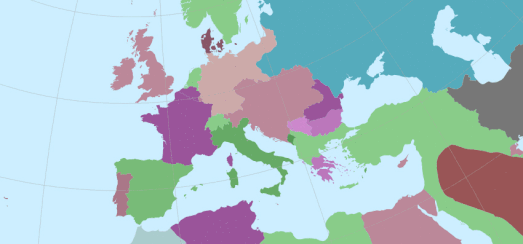The History of the World in Four Maps

The animated map above shows the changing borders of Europe, the Middle East and North Africa during the Twentieth Century. It is a a pretty good illustration of how geo-political developments demand frequently updated maps.
I created this animated map using Mundipedia. Munipedia is an interactive map which shows country borders for different dates in history. Enter a date into Munipedia and you can view how the world looked in that year. For example enter the year 1984 and you will see a divided Germany, split into East and West Germany. Skip forward a few years and in 1990 the map shows just the one Germany.
Not every single year is covered by the map. The legend above the map tells you the date currently being shown. The map also only covers modern history, starting as it does in the year 1899. History also seems to have come to a halt in 2015 and shows no changes to borders beyond this date.

Running Reality is another interactive map which is trying to build a map of the world over time. Using Running Reality you can view a map of any location in the world at any time during its history. In this way you can see how towns and cities have grown and fallen over time. You can also learn more about the people who lived there and the buildings in which they lived and worked.
To see how Running Reality works you can zoom-in on an individual city and then use the timeline to see how the city has changed over time. For example if you zoom in on New York and set the timeline to 1600 you will see no roads or buildings. Adjust the timeline to 1700 and a few roads and buildings can be seen in Manhattan. Advance another 100 years (to 1800) and the city has spread north as far as Greenwich Village and small developments have appeared in Brooklyn.
The map doesn't just show roads and physical topography. related to the date selected. It also shows buildings and people related to the visualized date. These buildings, places and people are interactive. Click on a person or buildings marker on the map and you can learn more about the person or building. So for example, if you click on a person, you might be able to learn when they were born and died. Click on a building and you might discover when it was first constructed.

Chronas is yet another interactive map which aims to provide a view of historical events across the globe and through time. This interactive map visualizes Wikipedia entries by date and by location and also shows country borders for different dates in history.
Chronas not only maps historical events but also provides a mapped overview of country boundaries for any given date. If you select a year from the time slider (running along the bottom of the map) the map will update to show how the world's borders existed at the chosen time. If you then click on a country or geographical area on the map a Wikipedia article on the selected historical region will open in the map sidebar. For example, if you select the year 573 AD from the time slider, you can select the Visigoths region on the map to learn more about these nomadic tribes during the first millennium.

The Ancient History Encyclopedia's Map of the Ancient World is an interactive map of the world from around 6,000 BCE to 270 BCE. The map plots historical civilizations and places by date. Change the date and the map changes to show the rough borders of the civilizations and people's of your selected time
The map carries a disclaimer that it is "only complete in the Mediterranean until around 270 BCE". However the map isn't limited to this period and location. If you only use the back and forward arrows to navigate the map then you might not realize that the map actually does include data for the rest of the world. You can also move forward in time beyond 270 BCE (although the map doesn't yet continue past the Roman Empire).


Comments